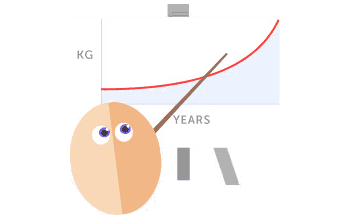Lovely to hear from you again. I missed your input. I am maintaining now, still struggle a bit with eating small amounts of things I really enjoy, it's an ongoing project which I hope to complete successfully.
Log in to view your messages, post comments, update your blog or tracker.
12 posts
Page 1 of 1
Good to see you back, had wondered where you'd run off, hope you had a wonderful holiday. 

Hi @Kencc Can you remind me how many days you use for your moving average? I'm trying to understand what is the best way to calculate a trendline.
Hi Kencc
Well done for heading back to target.
If your ears were burning on Christmas Day, it's because I was thinking of you - or rather, of your signature! I decided on impulse to make cranberry sauce, which I have eaten as a guest at other people's Christmasses but which was not part of my own traditions. I read the instructions on the packet of fresh cranberries - 120 grams of sugar, no way! I thought. I tasted a raw cranberry. Oh heck. All right then. I added about half the specified amount of sugar and cooked it up. Tasted. Still bleeugh. Put the rest of the sugar in. Tasted pretty good now! But why would I want to add a great wallop of dessert to my delicious roast goose main course? I won't be including cranberry sauce on my Christmas menu in future. Unless it is possible to develop a taste for the authentically sour/bitter?
Well done for heading back to target.
If your ears were burning on Christmas Day, it's because I was thinking of you - or rather, of your signature! I decided on impulse to make cranberry sauce, which I have eaten as a guest at other people's Christmasses but which was not part of my own traditions. I read the instructions on the packet of fresh cranberries - 120 grams of sugar, no way! I thought. I tasted a raw cranberry. Oh heck. All right then. I added about half the specified amount of sugar and cooked it up. Tasted. Still bleeugh. Put the rest of the sugar in. Tasted pretty good now! But why would I want to add a great wallop of dessert to my delicious roast goose main course? I won't be including cranberry sauce on my Christmas menu in future. Unless it is possible to develop a taste for the authentically sour/bitter?
Congrats! Happy Anniversary.
And thanks again for all your stuff on NEAT - it still drives my daily routines.
And thanks again for all your stuff on NEAT - it still drives my daily routines.
Impressive! Congratulations.
happy fastiversary! So great to see fasting being used effectively for weight maintenance. It's clear that frequent monitoring is essential to make sure the upward moves are stopped in their tracks. May I ask (sorry if you've already said) what kind of weight range do you allow yourself before taking action? Or do you purely go on the trendline?
Well done indeed!
I am pretty sure you have provided this info, but would you mind again giving the formula you use for the trend line? Moving average, but over how long?
I am pretty sure you have provided this info, but would you mind again giving the formula you use for the trend line? Moving average, but over how long?
Thanks @kencc
I've had a look at the Hacker's Diet website. I could almost wish my perpetually slender brother was fat, because he would just love this. He has an app for everything.
But as an only marginally geeky person, could I have the abridged version, viz: by "exponentially smoothed weighted moving average" do you mean:
trended value k= a*observed value k + (1-a)* trended value k-1 ?
And if so, what are you using for a?
I've had a look at the Hacker's Diet website. I could almost wish my perpetually slender brother was fat, because he would just love this. He has an app for everything.
But as an only marginally geeky person, could I have the abridged version, viz: by "exponentially smoothed weighted moving average" do you mean:
trended value k= a*observed value k + (1-a)* trended value k-1 ?
And if so, what are you using for a?
kencc wrote: With a simple moving average or trendline it can be disheartening because half the time you may be above the trendline. With this type of EMA, with a bit of care, it's possible to keep below the trendline most of the time even when daily weight fluctuates.
Keeping below the trendline more often only holds for a situation where you come from a high weight (included in the trend) and move to lower weight. The trendline just lags behind. In case you are gaining weight (come from a lower value) it is the other way around (as can be seen in your graph after Christmas).
The benefit of using a moving average of a number of days (say 7) is that it will indicate your 'true weight' more quickly. If you are moving down in weight that is something that might also be a positive motivation (as long as you do not get too much stress from some upward movement that is always happening on some days).
To give an example: suppose you come from 64 kg and on one day you suddenly weight 62 kg and remain stable on that weight the next days. After 7 days the moving average indicates your true weight of 62 kg. After those 7 days the EMA with 10% indicates 63.0. After 14 days it is still at 62.5 and at 21 days at 62.2 (as the difference becomes smaller, so is the 10% change in T). It takes 35 days to get to a (rounded) 62.0.
So, as with all ways of measuring: there are pro's and con's, and there is no 'best way'. Just be aware of the pro's and con's and choose the one that works best for you.
This is why, with a 10 day MA you have to move your data point for the average 5 days back: with the ten measurements you are actually measuring your weight of 5 days ago! So when you do that, the line fits much better!
Thanks, interesting discussion.
Your formula is the one I thought,@kencc, your value for what I called "a" is 0.1.
But the way you explain it is clearer. In effect you nudge the trendline by 10% of the amount that your weight that day has moved away from the trend.
I can see it works well, as you say, for the see-a-4lb-increase-on-the-scales-and-panic problem. It would be good if more of the people in the losing stage used a similar smoothing process, so they didn't get so upset by one day's bad number. I also think it's great the way you have tagged each day so you can look back and see how you earned your long-term results with fast days. It's a very satisfying picture.
I have some reservations about its usefulness for maintenance.
First, for someone who gets to goal and then stays there exactly, your formula must always produce a trendline above goal. Eventually it will approach goal, but it never quite reaches it because the old high weigh-ins are still playing a tiny part in the formula.
However, this is fixed if you overshoot goal a little bit and put the last few pounds back on. That can produce a trendline exactly at goal. This is pretty much your situation and arguably is a sensible one, particularly for people who have a very different regime after goal compared with the regime just before goal - since we lose the first few pounds quickly through water-loss, we probably regain a bit of permanent water when we stop whatever we were doing to lose weight.
Secondly, it does delay the process of noticing a permanent weight gain. Say you had a trendline at 160 and had been maintaining at that level, then in one day moved to 164 and stayed there. It would take about 14 days for the trendline to break your 163 trigger. In general, it will take 14 days for a 4 lb permanent weight gain to appear as a 3 lb gain in the trendline. Worse, if you have a steady half pound a day gain it still takes 13 days to break the 3lb tolerance, by which time you are 166.5. I think I'd be inclined to increase the sensitivity factor (how much your trendline reacts to one weight) from 10% to 30% for maintenance, so you can respond more quickly. Just my opinion.
Your formula is the one I thought,@kencc, your value for what I called "a" is 0.1.
But the way you explain it is clearer. In effect you nudge the trendline by 10% of the amount that your weight that day has moved away from the trend.
I can see it works well, as you say, for the see-a-4lb-increase-on-the-scales-and-panic problem. It would be good if more of the people in the losing stage used a similar smoothing process, so they didn't get so upset by one day's bad number. I also think it's great the way you have tagged each day so you can look back and see how you earned your long-term results with fast days. It's a very satisfying picture.
I have some reservations about its usefulness for maintenance.
First, for someone who gets to goal and then stays there exactly, your formula must always produce a trendline above goal. Eventually it will approach goal, but it never quite reaches it because the old high weigh-ins are still playing a tiny part in the formula.
However, this is fixed if you overshoot goal a little bit and put the last few pounds back on. That can produce a trendline exactly at goal. This is pretty much your situation and arguably is a sensible one, particularly for people who have a very different regime after goal compared with the regime just before goal - since we lose the first few pounds quickly through water-loss, we probably regain a bit of permanent water when we stop whatever we were doing to lose weight.
Secondly, it does delay the process of noticing a permanent weight gain. Say you had a trendline at 160 and had been maintaining at that level, then in one day moved to 164 and stayed there. It would take about 14 days for the trendline to break your 163 trigger. In general, it will take 14 days for a 4 lb permanent weight gain to appear as a 3 lb gain in the trendline. Worse, if you have a steady half pound a day gain it still takes 13 days to break the 3lb tolerance, by which time you are 166.5. I think I'd be inclined to increase the sensitivity factor (how much your trendline reacts to one weight) from 10% to 30% for maintenance, so you can respond more quickly. Just my opinion.
12 posts
Page 1 of 1
| Similar Topics |
|---|
Who is online
Users browsing this forum: No registered users and 2 guests







